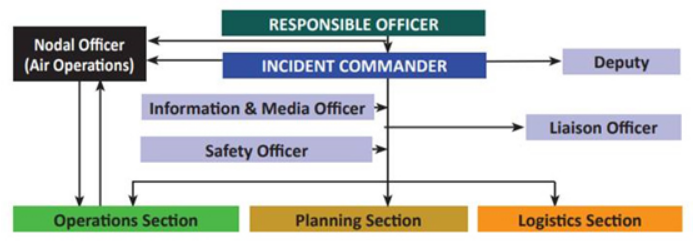Context: According to National Disaster Management Authority (NDMA), several states and Union territories (UTs) are yet to implement the Incident Response System (IRS), which is crucial for disaster response.
About Incident Response System (IRS):
- It envisages a composite team with various Sections to attend to all the possible response requirements to a disaster.
- The IRS designates officers to perform various duties and get them trained in their respective roles.
- It emphasizes the need for proper documentation of various activities for better planning, accountability and analysis.
- This will greatly help in reducing chaos and confusion during the response phase.
- National Disaster Management Authority (NDMA) has issued the Guidelines on the Incident Response System (IRS) under Section 6 of the DM Act, 2005.
- AIm: Effective, efficient and comprehensive management of disasters in India.
- Vision of IRS: To minimize loss of life and property by strengthening and standardising the disaster response mechanism in the country.
- It is an effective mechanism for reducing ad-hoc measures in response.
- IRS Organisation:
 Image Source: NDMA
Image Source: NDMA
- Organisational Flexibility: The IRS is a flexible system and all its Sections need not be activated in every situation at the same time.
- Only required sections may be made operational as and when required.
- This system envisages that the roles and duties shall be laid down in advance, the personnel earmarked and trained in their respective roles and duties.
National Disaster Management Authority (NDMA)
- Origin: Disaster Management Act of 2005 established NDMA in 2006, as a statutory body for disaster management in India
- Composition: Its chairman is the prime minister, and there are nine other members. Vice-Chairperson duties are assigned to one of the nine participants.
- Decentralisation: Disaster Management Act also provided for the establishment of District Disaster Management Authorities (DDMA), which would be co-chaired by the Chairpersons of local organisations, and State Disaster Management Authorities (SDMAs), which would be led by the respective Chief Ministers.
- Objective of NDMA
- To pioneer and put into practise a comprehensive and integrated approach to disaster management in India.
- To design a comprehensive, proactive, technology-driven, and sustainable development plan that incorporates all stakeholders and promotes a culture of prevention, preparedness, and mitigation in order to make India safer and more disaster-resilient.
National Disaster Reaction Force (NDRF)
- The NDRF was constituted under Section 44 of the Disaster Management Act, 2005 for a specialized response to natural and man-made disasters.
- At present, NDRF comprise of 12 battalions, with each battalion consisting 1149 personnel.
|
News Source: HT
![]() 9 Aug 2023
9 Aug 2023
 Image Source: NDMA
Image Source: NDMA